When you think about the largest ports in the United States, a few names stand out.
One of the most famous ports is the Port of Los Angeles. It’s the biggest container port in the U.S. Each year, millions of TEUs (twenty-foot equivalent units) pass through this port.
Right next to it is the Port of Long Beach. Together with the Port of Los Angeles, they form one of the largest port complexes in the world. They handle a major portion of the cargo entering and leaving the country.
Moving to the East Coast, the Port of New York and New Jersey plays a huge role. This port is critical for goods coming into the northeastern U.S. It handles everything from raw materials to consumer goods.
Down South, you have the Port of Houston. This port is key for American exports, especially petrochemicals. It’s one of the busiest ports in terms of tonnage.
Another important port is the Port of South Louisiana. It’s known for handling a variety of bulk cargo. This makes it essential for agricultural and industrial products.
A bit less famous but equally important is the Port of Savannah in Georgia. It is one of the fastest-growing container ports in America, thanks to its deepwater facilities and expanding infrastructure.
This article delves into the impressive scale, operations, and impact of America’s largest port, exploring how it has become an indispensable link in the global supply chain and a cornerstone of U.S. trade infrastructure.
Port of Los Angeles, California
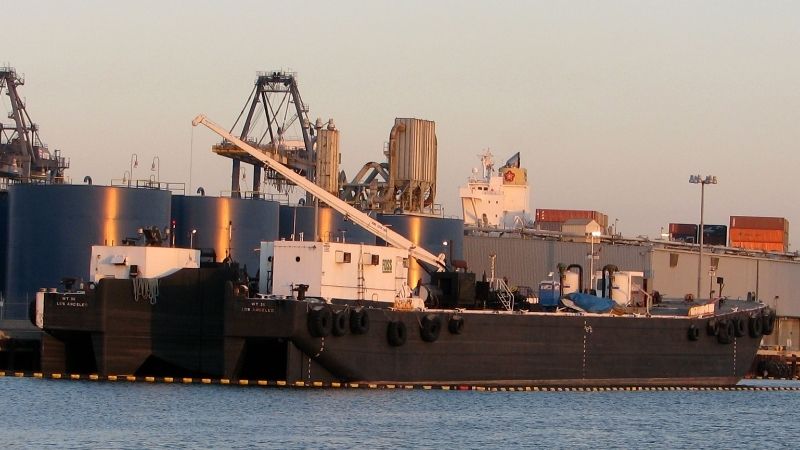
The Port of Los Angeles, often referred to as America’s Port, is the largest and busiest container port in the United States and a global leader in international trade.
Located in San Pedro Bay, this sprawling seaport encompasses 7,500 acres of land and water with 43 miles of waterfront.
Established in 1907, the Port of Los Angeles has held the title of the nation’s top container port for 24 consecutive years, from 2000 to 2023. It serves as a critical gateway for trade between the United States and Asia.
The Port of Los Angeles is not just a hub for cargo; it’s also a major economic driver for the region and the nation.
In 2023, the port facilitated trade valued at billions of dollars, contributing significantly to the local and national economy.
The Port of Los Angeles, together with the neighboring Port of Long Beach, forms the San Pedro Bay Port Complex, which ranks as the 9th busiest port complex in the world.
This dynamic duo handles approximately 29% of all containerized waterborne international trade in the United States.
- Container volume: 9.3 million TEUs (2019)
- Annual cargo tonnage: 222 million metric revenue tons
- Leading trading partners: China (including Hong Kong), Japan, and Vietnam (2020)
- Total containers: 9,911,159 TEUs (2022)
Port of Long Beach, California
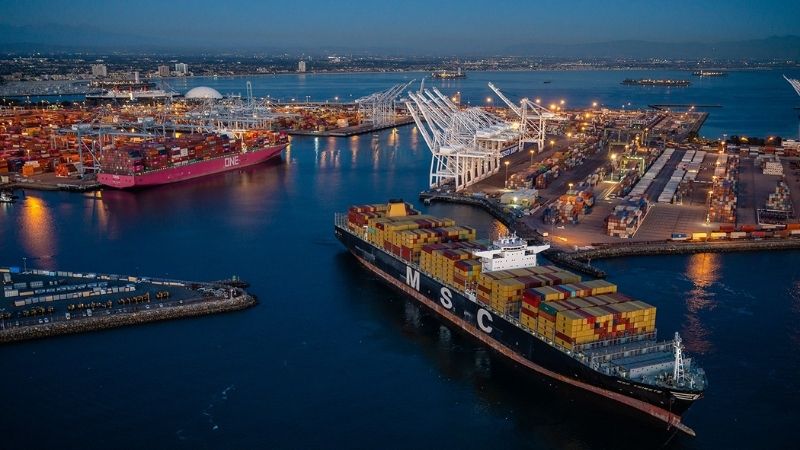
The Port of Long Beach is one of the busiest container ports in the United States.
Founded on June 24, 1911, it has a rich history of over a century of maritime operations and development.
The port features 80 berths, 10 piers, and 22 shipping terminals, including six container terminals. It’s equipped with 83 ship-to-shore container cranes and over 1,900 pieces of cargo-handling equipment.
The port has excellent rail and road connections, including on-dock rail facilities, which enhance its efficiency in moving cargo to and from inland destinations.
It serves 175 shipping lines with connections to 217 seaports around the world, making it a vital link in global supply chains.
- Container volume: 4,291,626 TEUs (Calendar Year to Date – June 2024)
- Annual cargo tonnage: 78.2 million metric revenue tons
- Total containers: 4,291,626 TEUs (Calendar Year to Date – June 2024)
Port of New York and New Jersey, New York
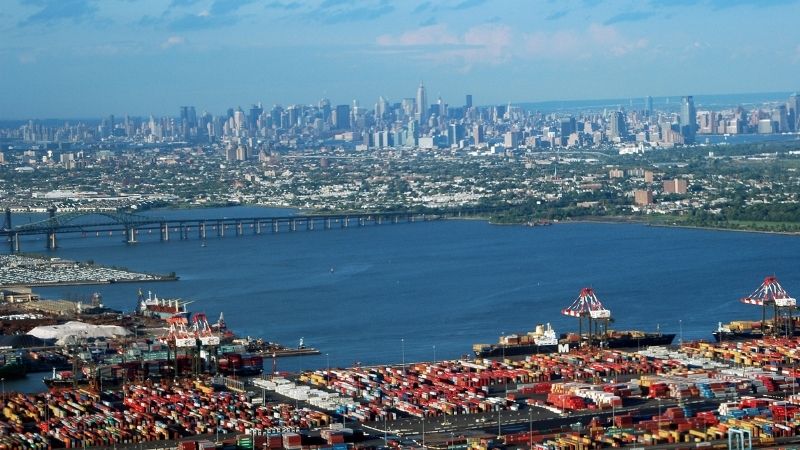
The Port of New York and New Jersey is a busy and important hub on the East Coast. It is located in New York.
This port is the largest on the U.S. East Coast and the third largest in the nation. It’s known for receiving 72% of the first port of calls on the East Coast, making it a key entry point.
The Port Authority invested $1.7 billion to raise the roadway of a bridge, allowing larger ships to pass. This improvement boosts efficiency and helps keep goods moving swiftly to consumers.
Being in a densely populated consumer market gives it a competitive edge. Quick delivery times are a big reason why this port stands out.
- Container volume: 7.8 million TEUs (2023)
- Annual cargo tonnage: 74 million metric revenue tons
- Leading trading partners: China, Italy, and Germany
- Total containers: 7.8 million TEUs (2023)
Port of Savannah, Georgia
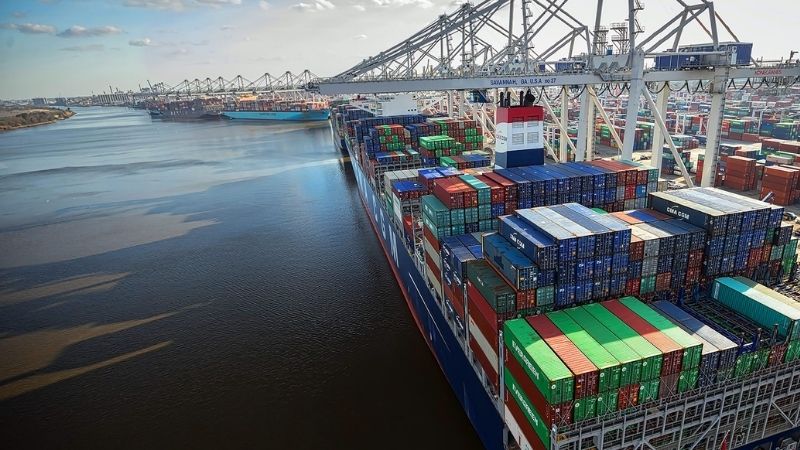
The Port of Savannah is one of the most important seaports in the U.S. Located in Savannah, Georgia, it gives you direct access to major highways, I-95 and I-16.
This means quicker transportation times for goods traveling to and from the port.
It covers a massive area. Its Garden City Terminal alone spans 1,345 acres, making it the largest container terminal in North America.
- Container volume: 4.35 million TEUs (2018)
- Annual cargo tonnage: 37.77 million (FY2020)
- Total containers: 451,670 TEUs (February 2024)
Port of Seattle and Tacoma, Washington
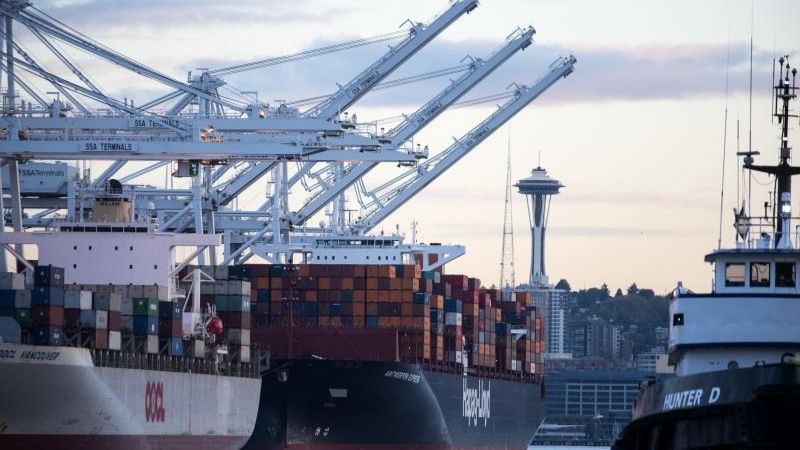
The Port of Seattle and the Port of Tacoma form the Northwest Seaport Alliance. This partnership creates a major cargo hub in the Pacific Northwest. Your goods can easily flow through this fourth-largest container gateway in North America.
The ports manage various types of cargo, including containers, breakbulk, autos, and some bulk terminals. Together, they handle a large portion of the region’s international trade.
Terminal 5 in Seattle has seen significant investments, including over $300 million in infrastructure improvements. These upgrades help accommodate ever-larger container vessels, boosting efficiency.
- Container volume: 3.68 million TEUs
- Total containers: 4.2 million
Port of Houston, Texas
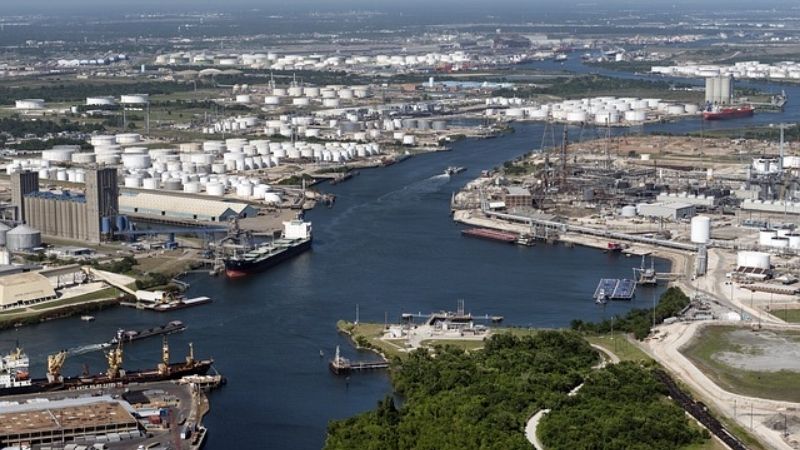
Port Houston is one of the largest and busiest ports in the United States. It stretches over a length of about 52 miles along the Houston Ship Channel.
One key aspect of Port Houston is its impressive container handling capacity. It accounts for 97% of the market share in container shipping in Texas.
Port Houston consists of eight public terminals. These terminals include some of the most efficient container handling facilities in the country.
Port Houston is strategically located. It provides easy access to both international and domestic markets. This positioning helps drive international trade.
- Container volume: 3.8 million TEUs (Twenty-foot Equivalent Units) 2023
- Annual cargo tonnage: 276 million short tons (2023)
Port of Oakland
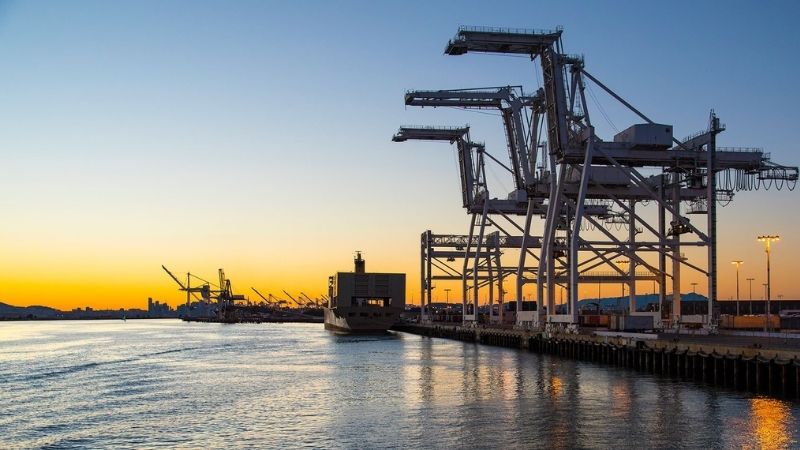
The Port of Oakland stands as a vital hub for international trade on the West Coast of the United States.
Oakland plays a crucial role in facilitating trade, particularly with Asia.
The port features four marine terminals with 27 berths and 25 cranes, providing ample infrastructure for loading and unloading operations.
With depths ranging from 42 to 50 feet, the port can accommodate vessels up to 13,000 TEU capacity. This depth allows Oakland to service some of the largest container ships in operation.
The port of Oakland boasts excellent intermodal connectivity. It’s served by both Union Pacific and BNSF railroads, with facilities located adjacent to the marine terminal area. This setup enables efficient transfer of cargo between ships, trains, and trucks.
While primarily focused on international trade, the port also handles domestic cargo, with about 5% of its trade serving destinations like Hawaii.
- Container volume: 2,065,709 TEUs (Twenty-foot Equivalent Units) in 2023
South Carolina Port: Port of Charleston

The Port of Charleston is the 8th largest U.S. container port. This port plays a crucial role in the supply network, especially for the Southeast.
At the heart of Charleston’s economic prowess lies its world-class port infrastructure. This deep-water port, now boasting a depth of 52 feet—the deepest on the East Coast—has positioned Charleston as a pivotal player in international trade.
The port’s ability to handle fully loaded mega container ships at any time, regardless of tides, gives South Carolina a significant competitive edge in the global marketplace.
The strategic importance of Charleston extends beyond its maritime capabilities. The city is home to the state’s busiest passenger airport, enhancing its accessibility for both business and leisure travelers.
Perhaps one of Charleston’s most significant assets is its integrated transportation network.
This sophisticated system allows shipments to reach most domestic markets within 48 hours, a critical factor for businesses operating in today’s fast-paced, just-in-time economy.
- Container volume: Nearly 2.6 million TEUs (Twenty-foot Equivalent Units)
- Total containers: 1.4 million pier containers
Port of Virginia
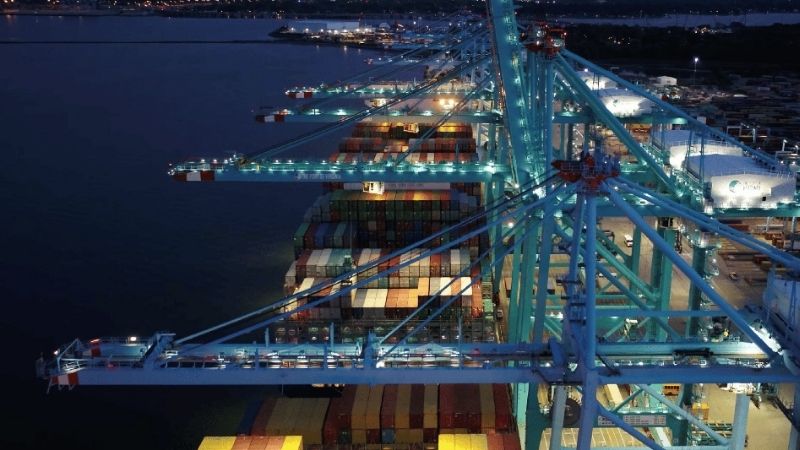
Strategically located in Hampton Roads, it features the deepest water harbor on the U.S. East Coast, with 50-foot channels both inbound and outbound.
One of the port’s most significant strengths lies in its strategic location and extensive connectivity. It can deliver goods to 75% of the U.S. population within just two days, making it the East Coast’s rail gateway of choice with direct connections to key inland and Midwest markets.
This logistical advantage is further enhanced by the port’s robust shipping network, with nearly 30 international shipping lines offering direct, dedicated service to and from Virginia, connecting to over 200 countries worldwide.
- Container volume: 3.7 million TEUs
- Total containers: 2,053,524 containers (2022)
West Coast and East Coast: Everything You Should Know
The Importance of West Coast Ports
The West Coast is home to some of the busiest and most important ports in the US, such as the Port of Los Angeles and the Port of Long Beach. These ports serve as gateway hubs for goods arriving from Asia. They handle millions of TEUs (twenty-foot equivalent units) annually, making them critical to your everyday goods and commerce.
Due to their proximity to major Pacific trade routes, these ports significantly reduce travel time for ships coming from Asian markets. Ports like Oakland in California also play a key role by connecting goods to rail and truck networks that distribute products across the country.
East Coast and Gulf Coast Shipping Hubs
The East Coast and Gulf Coast also host vital shipping hubs. For example, the Port of Houston in Texas is one of the busiest ports, crucial for the energy sector. Its strategic location along the Gulf Coast makes it important for shipping oil, gas, and chemicals.
On the East Coast, ports like the Port of Savannah in Georgia and the Port of Charleston in South Carolina are essential for trade with Europe and beyond. These ports benefit from their deep harbors and modern infrastructure, allowing them to handle large container ships and significant volumes of cargo.
The Port of South Louisiana is another key player, being one of the largest tonnage ports in the Western Hemisphere. It mainly deals with bulk cargo like grain and chemicals. These ports support regional economies and provide critical points for the import and export of goods across the Atlantic.
Popular China-US Shipping Routes: Costs and Transit Times
Shipping goods from China to the United States involves several key routes and ports. The transit times, costs, and specific paths can vary, making it important to choose the best option for your needs.
| Origin Port | Destination Port | 20ft Container Cost | 40ft Container Cost | Transit Time |
| Shanghai | Los Angeles | $1,300 – $2,300 | $2,000 – $3,000 | 14-20 days |
| Shenzhen | Los Angeles | $1,300 – $2,300 | $2,000 – $3,000 | 14-20 days |
| Ningbo | Los Angeles | $1,300 – $2,300 | $2,000 – $3,000 | 14-20 days |
| Shanghai | New York/NJ | $2,300 – $3,500 | $3,000 – $5,000 | 30-40 days |
| Shenzhen | New York/NJ | $2,300 – $3,500 | $3,000 – $5,000 | 30-40 days |
| Guangzhou | Los Angeles | $1,300 – $2,300 | $2,000 – $3,200 | 14-20 days |
| Tianjin | Los Angeles | $1,300 – $2,300 | $2,000 – $3,000 | 14-20 days |
It’s important to note that these prices are approximate and can fluctuate significantly based on factors such as fuel costs, demand, and global events. Recent reports indicate that freight rates have been increasing, with some routes seeing price hikes of 30-40% month-over-month.
The routes to the West Coast (e.g., Los Angeles) are generally less expensive than those to the East Coast (e.g., New York/New Jersey) due to the shorter distance.
The transit time for West Coast routes is typically 14-20 days, while East Coast routes can take 30-40 days via the Panama Canal.
Additionally, these rates usually cover the basic ocean freight charges. Other costs, such as documentation fees, customs clearance, inland transportation, and potential surcharges, may apply, increasing the total shipping cost.
Given the volatility in the shipping industry, it’s advisable to get updated quotes from Luckystar Logistics for the most current rates and to consider factors beyond just cost, such as reliability and transit times.
Frequently Asked Questions
Which port holds the title of the largest on the East Coast of the United States?
The Port of New York and New Jersey is the largest port on the East Coast and a major hub for both imports and exports.
How many sea ports are there across the United States?
The United States has over 360 seaports. These ports handle a variety of goods and services, playing a vital role in the economy.
The Port of Miami, also known as the “Cruise Capital of the World,” is the largest port in Florida. It’s not only busy with cargo but also with numerous cruise ships.
What is the biggest port in the state of Florida?
The Port of Miami, also known as the “Cruise Capital of the World,” is the largest port in Florida. It’s not only busy with cargo but also with numerous cruise ships.
